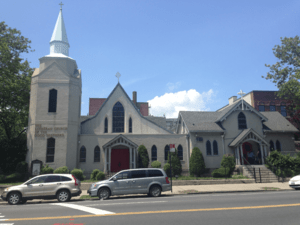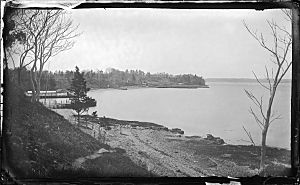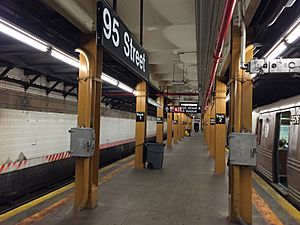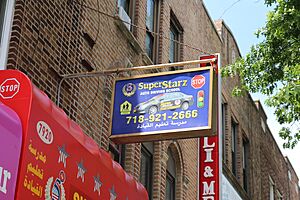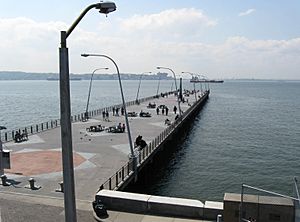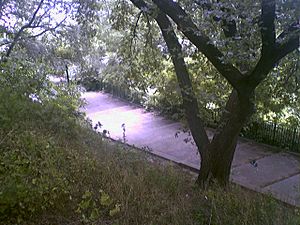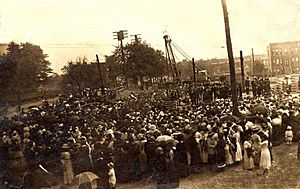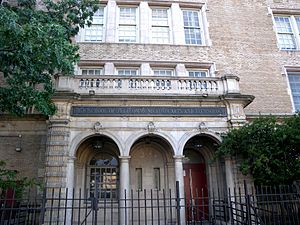Bay Ridge, Brooklyn facts for kids
Quick facts for kids
Bay Ridge
|
|
|---|---|
|
Neighborhood of Brooklyn
|
|
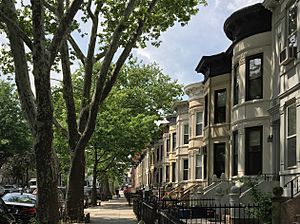 |
|
| Country | |
| State | |
| City | New York City |
| Borough | Brooklyn |
| Community District | Brooklyn 10 |
| Area | |
| • Total | 2.12 sq mi (5.49 km2) |
| • Land | 2.12 sq mi (5.49 km2) |
| • Water | 0 sq mi (0 km2) |
| Population
(2010)
|
|
| • Total | 79,371 |
| • Density | 37,440/sq mi (14,457/km2) |
| Time zone | UTC−5 (Eastern) |
| • Summer (DST) | UTC−4 (EDT) |
| ZIP Codes |
11209, 11220
|
| Area code | 718, 347, 929, and 917 |
Bay Ridge is a neighborhood located in the southwest part of Brooklyn, a borough of New York City. It is bordered by Sunset Park to the north and Dyker Heights to the east. To the west, you'll find the Narrows and the Belt Parkway. To the south are the Fort Hamilton Army Base and the famous Verrazzano-Narrows Bridge. Sometimes, the area south of 86th Street is called Fort Hamilton.
Bay Ridge used to be part of a town called New Utrecht. It had two smaller villages: Yellow Hook and Fort Hamilton. Yellow Hook was renamed Bay Ridge in 1853 because of its beautiful bay views and high land. In the mid-1800s, it became a popular summer spot. When the New York City Subway's Fourth Avenue Line (now the R train train) arrived in 1916, Bay Ridge grew into a busy residential area. The neighborhood is known for its large Norwegian community, but it also has many Irish, Italian, Arab, and Greek families.
Bay Ridge is part of Brooklyn Community District 10. Its main ZIP Codes are 11209 and 11220. The New York City Police Department's 68th Precinct keeps the area safe. For local government, it is represented by the 43rd District of the New York City Council.
Contents
History of Bay Ridge
How Bay Ridge Started
Long ago, the Canarsee Indians, part of the Lenape people, lived and hunted in this area. They had paths that went through what is now Bay Ridge. In the early 1600s, they started trading with Dutch and English settlers.
The first European settlers arrived in 1636. Dutch farmers bought land and soon, the Canarsee people moved away. Bay Ridge was the western part of New Utrecht, a Dutch settlement founded in 1657. The area had two small villages: Yellow Hook (named for its soil color) and Fort Hamilton (named after the military base).
Yellow Hook was mostly farmland until the 1840s. In 1853, people changed its name to "Bay Ridge" to avoid any connection to yellow fever. The new name came from the area's views of New York Bay and its high land. Wealthy people started building beautiful country homes along Shore Road, looking out over the water.
Fort Hamilton began to grow in the 1830s as a resort area. Workers built a community with stores, houses, churches, and a school near the fort. It was connected to other parts of Brooklyn by stagecoach and to Staten Island and Manhattan by ferry.
In the mid-1800s, many large country houses were built in Bay Ridge, especially along Shore Road. These homes had amazing views of the New York Harbor. People could even use telephones to talk to their businesses in Manhattan! Many of these grand homes were built in styles like Greek Revival and Gothic Revival.
By the late 1800s, there were plans to build wide, tree-lined streets in Bay Ridge, like Bay Ridge Parkway and Shore Road.
Subway and Growth
For a long time, Bay Ridge was a quiet, rural place. People mainly got around by stagecoaches or steam trolleys. In 1892, the first electric trolley line came to Brooklyn, making it easier to reach Bay Ridge. This caused land prices to go up.
In the early 1900s, a building boom started. Thousands of people moved to South Brooklyn from Manhattan. In 1903, plans for a Fourth Avenue subway line were made. This news made property values in Bay Ridge double! Houses were sold even before they were finished.
The subway project had some delays, but construction finally began in 1909. The subway line opened to 59th Street in 1915 and to 86th Street in 1916. This really sped up development in Bay Ridge. By the 1920s, many old farms and houses were replaced by apartment buildings. Schools, churches, stores, and movie theaters were also built.
The Fourth Avenue subway was extended to Bay Ridge–95th Street in 1925. By then, Bay Ridge's population had more than doubled since 1900.
In the 1800s and early 1900s, many Norwegian and Danish sailors moved to Bay Ridge and nearby Sunset Park. Eighth Avenue in this area was even nicknamed "Lapskaus Boulevard," after a Norwegian beef stew!
The Verrazzano Bridge
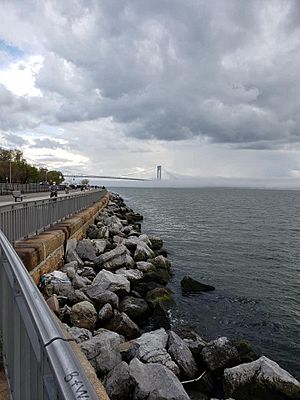
For many years, people talked about building a tunnel or bridge from Bay Ridge to Staten Island. In 1927, an engineer named David B. Steinman suggested building a large bridge called the "Liberty Bridge."
Later, Robert Moses, a powerful city planner, announced plans for what would become the Verrazzano-Narrows Bridge in 1947. Some people in Bay Ridge were against the bridge because they thought it would change their neighborhood too much. However, the bridge was approved.
The construction of the bridge's approach meant that 7,500 people had to move from their homes. Also, Fort Lafayette, an old fort that was part of New York City's defense, was destroyed to make way for the bridge's east tower. The Verrazzano-Narrows Bridge finally opened in 1964.
In 2007, a strong tornado hit Bay Ridge, especially around 68th Street and Bay Ridge Avenue. It damaged many houses and knocked down trees. The tornado was very powerful, with winds between 111 and 135 miles per hour.
Who Lives in Bay Ridge?
Bay Ridge is a very diverse neighborhood. In 2020, its population was about 111,952 people. This was a big increase from 79,371 people in 2010.
According to the 2010 US Census, about 60% of the people in Bay Ridge were White. About 20% were Hispanic, and 15% were Asian. There were also smaller groups of Black people and people from two or more races.
In 2018, the average life expectancy in Bay Ridge was 83.1 years, which is higher than the average for New York City. The median age in the neighborhood is 38 years old.
Weather in Bay Ridge
Bay Ridge, Brooklyn, has a humid subtropical climate. This means it has hot, humid summers and mild winters.
| Climatic scheme | Initials | Description |
|---|---|---|
| Köppen system | Cfa | humid subtropical climate |
| Trewartha system | Do | Temperate oceanic climate |
| Alisov system | N/A | Temperate climate |
| Strahler system | N/A | Moist continental climate |
| Thornthwaite system |
|
Moist subhumid |
| Neef system | N/A | Temperate climate |
| Weather chart for Bay Ridge, Brooklyn | |||||||||||||||||||||||||||||||||||||||||||||||
|---|---|---|---|---|---|---|---|---|---|---|---|---|---|---|---|---|---|---|---|---|---|---|---|---|---|---|---|---|---|---|---|---|---|---|---|---|---|---|---|---|---|---|---|---|---|---|---|
| J | F | M | A | M | J | J | A | S | O | N | D | ||||||||||||||||||||||||||||||||||||
|
0
37
31
|
0
40
33
|
0
48
39
|
0
60
49
|
0
70
59
|
0
78
68
|
0
84
75
|
0
82
72
|
0
76
66
|
0
64
55
|
0
52
45
|
0
43
38
|
||||||||||||||||||||||||||||||||||||
| temperatures in °F precipitation totals in inches |
|||||||||||||||||||||||||||||||||||||||||||||||
|
Metric conversion
|
|||||||||||||||||||||||||||||||||||||||||||||||
| Month | Jan | Feb | Mar | Apr | May | Jun | Jul | Aug | Sep | Oct | Nov | Dec | Year |
|---|---|---|---|---|---|---|---|---|---|---|---|---|---|
| Record high °F (°C) | 68 (20) |
77 (25) |
81 (27) |
90 (32) |
92 (33) |
96 (36) |
102 (39) |
95 (35) |
96 (36) |
92 (33) |
75 (24) |
71 (22) |
102 (39) |
| Mean maximum °F (°C) | 57.0 (13.9) |
59.7 (15.4) |
69.2 (20.7) |
80.0 (26.7) |
88.3 (31.3) |
90.2 (32.3) |
94.5 (34.7) |
91.5 (33.1) |
89.8 (32.1) |
79.6 (26.4) |
69.2 (20.7) |
61.3 (16.3) |
95.4 (35.2) |
| Mean daily maximum °F (°C) | 37.2 (2.9) |
40.2 (4.6) |
48.3 (9.1) |
59.5 (15.3) |
69.7 (20.9) |
77.9 (25.5) |
84.0 (28.9) |
82.1 (27.8) |
75.9 (24.4) |
64.1 (17.8) |
52.1 (11.2) |
43.2 (6.2) |
61.2 (16.2) |
| Daily mean °F (°C) | 34.1 (1.2) |
36.6 (2.6) |
43.7 (6.5) |
54.3 (12.4) |
64.6 (18.1) |
73.2 (22.9) |
79.4 (26.3) |
77.3 (25.2) |
71.0 (21.7) |
59.8 (15.4) |
48.7 (9.3) |
40.6 (4.8) |
56.9 (13.9) |
| Mean daily minimum °F (°C) | 31.0 (−0.6) |
33.0 (0.6) |
39.1 (3.9) |
49.0 (9.4) |
59.4 (15.2) |
68.4 (20.2) |
74.7 (23.7) |
72.4 (22.4) |
66.1 (18.9) |
55.4 (13.0) |
45.3 (7.4) |
38.0 (3.3) |
52.7 (11.5) |
| Mean minimum °F (°C) | 10.5 (−11.9) |
14.3 (−9.8) |
22.5 (−5.3) |
34.5 (1.4) |
46.2 (7.9) |
55.8 (13.2) |
65.1 (18.4) |
63.5 (17.5) |
53.7 (12.1) |
40.2 (4.6) |
28.9 (−1.7) |
22.4 (−5.3) |
8.6 (−13.0) |
| Record low °F (°C) | 3 (−16) |
−1 (−18) |
14 (−10) |
27 (−3) |
35 (2) |
51 (11) |
61 (16) |
61 (16) |
49 (9) |
33 (1) |
16 (−9) |
13 (−11) |
−1 (−18) |
Community Life
Bay Ridge is famous for its Norwegian community. In 1971, the Norwegian community here was so big, it was called the fourth-largest Norwegian "city" in the world! They still celebrate the annual Norwegian Constitution Day Parade, also known as the Syttende Mai Parade. Hundreds of people in traditional clothes march down Third Avenue. The celebration ends in Leif Ericson Park, where "Miss Norway" is crowned near a statue of Leif Ericson. The statue was a gift from the Crown Prince Olav, Prince of Norway, in 1939.
Bay Ridge still has a large Norwegian population today. Over the years, more Irish, Italian, Greek, Russian, and Polish people moved to the area. More recently, many families from the Middle East and North Africa, especially Arab Americans, have made Bay Ridge their home. The New York Times even called it "the heart of Brooklyn's Arab community." Bay Ridge has one of the largest Arab-American communities in the United States.
Besides these groups, there are also many Puerto Ricans, Mexicans, and people from Central America and the Dominican Republic.
Bay Ridge has many different kinds of restaurants, especially along its main shopping streets, Third and Fifth Avenues.
The neighborhood also has a large number of older residents. Many families have lived here for generations.
Local News
You can read about Bay Ridge in local newspapers like The Home Reporter, Sunset News, The Bay Ridge Courier, and Bay Ridge News. The Brooklyn Daily Eagle also covers the area.
New Buildings
In the 1990s and 2000s, some older two-family houses were replaced by new apartment buildings called "Fedder Homes." In 2005, local leaders worked together to create new rules for building, to help keep the neighborhood's character. The tallest buildings in Bay Ridge are the six-story apartment complexes along Shore Road.
Cool Places to See
Points of Interest
- 8200 Narrows Avenue House: This house, often called the "Gingerbread House," was designed in 1917 and is a city landmark.
- American Veterans Memorial Pier (also known as the 69th Street Pier): Located at Bay Ridge Avenue and Shore Road, this is a great spot for seaside fun. People come here to fish and walk along the water. The pier has a sculpture that shines a light to remember those who died on September 11. You can also catch a ferry from here to Manhattan.
- Bennet-Farrell-Feldman House: This house at 119 95th Street was built in 1847 and is now a city landmark.
- Doctors' Row: These are a series of houses along Bay Ridge Parkway between Fourth and Fifth Avenues.
- Fort Hamilton: This is an active military base located near the Verrazzano-Narrows Bridge.
- Owl's Head Park (also known as Bliss Park): This park in the northwest part of the neighborhood used to be a private estate. It's a 24-acre park with a modern skate park, a dog run, a playground, and basketball courts. It has the first concrete skatepark built in Brooklyn.
- The Senator Street Historic District is a special area recognized for its history.
- Shore Road Park: This park hosts a weekly 3-mile run.
- Step streets: These are public staircases built on steep hills where cars can't drive, allowing people to walk up and down.
- St. John's Episcopal Church: This historic church is where famous generals Robert E. Lee and Thomas J. "Stonewall" Jackson once spent time.
Fort Hamilton Army Base
The historic Fort Hamilton Army Base is in the southwest corner of Brooklyn. It's one of the military bases that supports the Army National Guard and the United States Army Reserve in the New York area. The base is considered part of Bay Ridge, and children living on the base go to Bay Ridge schools.
Fort Hamilton is also home to the Harbor Defense Museum, which is one of the few museums in the neighborhood.
Doctors' Row
Doctors' Row is a group of rowhouses on Bay Ridge Parkway between 4th and 5th Avenues. They were built in the early 1900s before the subway line opened. These 54 houses show off architectural styles like Renaissance Revival. In 2019, Doctors' Row became an official city historic district, the first in Bay Ridge.
Fire Safety
The New York City Fire Department (FDNY) has two fire stations in Bay Ridge. Engine Co. 241/Ladder Co. 109 is on 3rd Avenue, and Engine Co. 242, which mostly serves Fort Hamilton, is on 5th Avenue.
Mail and ZIP Codes
Most of Bay Ridge uses ZIP Code 11209. A small part north of 65th Street uses 11220. The United States Post Office has two locations: Ovington Station on 4th Avenue and Fort Hamilton Station on 5th Avenue.
Schools and Libraries
Many adults in Bay Ridge have a college education, similar to other parts of New York City. In Bay Ridge, 46% of adults aged 25 and older have a college degree or higher.
Students in Bay Ridge and Dyker Heights tend to do well in school. Fewer elementary school students miss many days of school compared to the rest of the city. Also, 82% of high school students graduate on time, which is higher than the city average.
Schools in Bay Ridge
The New York City Department of Education runs the public schools here. Some of the schools include:
- PS 102
- PS 170
- PS 127
- PS 185 (Walter Kassenbrock Elementary School)
- PS 104 (Fort Hamilton School)
- PS 264 (Bay Ridge Elementary School for the Arts)
- PS/IS 30 (Mary White Ovington)
- PS 413 Joanne Seminara School of Law and Medicine
- IS 259 (William McKinley Junior High School)
- Fort Hamilton High School
- High School of Telecommunications (which used to be Bay Ridge High School, an all-girls school)
There are also private schools in Bay Ridge, such as:
- Angels Catholic Academy
- Bay Ridge Preparatory School
- Poly Prep Country Day School
- Visitation Academy
- Adelphi Academy
- Fontbonne Hall Academy
- St. Patrick Elementary School
- D., G. Kaloidis Parochial School
- Xaverian High School
Fort Hamilton High School was built in the 1940s on the land where the Crescent Athletic Club, a country club, used to be.
Libraries
The Brooklyn Public Library (BPL) has two libraries in Bay Ridge.
- The Bay Ridge Library is at 7223 Ridge Boulevard. It started as a reading club in 1880 and became a BPL branch in 1901. The current building opened in 1960 and was renovated in 2004.
- The Fort Hamilton Library is at 9424 Fourth Avenue. It was built as a Carnegie library in 1906. It has been renovated many times, most recently in 2011.
Getting Around Bay Ridge
The neighborhood is served by the R train train on the BMT Fourth Avenue Line of the New York City Subway. You can catch it at the Bay Ridge Avenue and 95th Street stations.
There are also MTA express bus routes like the X27, X37, which go to Manhattan. The X27 also runs on weekends. The X28, X38 buses serve the eastern part of Bay Ridge. Many people prefer the express bus because it's more comfortable, even if it costs a bit more than the subway.
Bay Ridge is easy to reach by car, as it's surrounded by the Belt Parkway and Gowanus Expressway. Local bus routes include B1, B4, B8, B9, B16, B37, B63, B64, B70, S53, S79 SBS, S93.
A freight-only train line, the Bay Ridge Branch, connects to the Long Island Rail Road.
In June 2017, Bay Ridge became the starting point for NYC Ferry's South Brooklyn route, offering another way to travel by water.
Famous People from Bay Ridge
- Sal Albanese (born 1949), a politician who was on the New York City Council.
- Maria Bartiromo (born 1967), a TV news anchor for Fox News, grew up here.
- Bob Berg (1951-2002), a jazz saxophonist.
- Alexis Bittar (born 1968), a jewelry designer.
- Richard Bright (1937-2006), an actor.
- Jason Calacanis (born 1970), a technology entrepreneur.
- Ron Chernow (born 1949), a writer of biographies.
- Chuck Connors (1921-1992), an actor known for The Rifleman, grew up on Senator Street.
- Bill Corbett (born 1960), a writer and actor from Mystery Science Theater 3000.
- C. C. DeVille (born 1962), guitarist for the band Poison, went to schools in Bay Ridge.
- Calvert DeForest (1921-2007), an actor and comedian.
- Chris Distefano (born 1984), a comedian.
- Jimmy Fallon (born 1974), a famous television host and comedian.
- Joel Gertner (born 1975), a professional wrestling TV personality.
- Robert Ginty (1948-2009), an actor.
- John Gray, who created the TV show Ghost Whisperer.
- Emmett Grogan (1942-1978), a novelist.
- James Hayden (1953-1983), an actor.
- Stonewall Jackson (1824-1863), a famous General, was once stationed at Fort Hamilton.
- Willard F. Jones (1890-1967), a naval architect.
- Jackie Kelk (1923-2002), an actor.
- Walter Kelleher (?-1970), a photographer.
- June Kirby (1928–2022), an actress and model.
- Lordz of Brooklyn members Adam "ADM" McLeer and Michael "Mr. Kaves" McLeer were born and still live in Bay Ridge.
- Robert E. Lee (1807-1870), another famous General, was also stationed at Fort Hamilton.
- Nadine Macaluso (born 1967), a psychologist and former model.
- Kevin Matthews (born 1983), a professional wrestler.
- Allyn Ann McLerie (1926-2018), an actress.
- Giulia Melucci (born 1966), an author.
- Daniel J. Murphy (1922-2001), a US Navy Admiral.
- Yannis Pappas, a comedian.
- Pee Wee Reese (1918-1999), a shortstop for the Brooklyn Dodgers, lived in Bay Ridge.
- Jerry Rosenberg (born c. 1934), a local business owner.
- Lillian Russell (1860-1922), an operetta singer.
- Hubert Selby Jr. (1928-2004), a novelist.
- Frank Seminara (born 1967), a former professional baseball player.
- Brandon Silvestry (born 1979), a professional wrestler.
- Duke Snider (1926-2011), a Brooklyn Dodger, rented a home here.
- Gilbert Sorrentino (1929-2006), a novelist and poet.
- Janet Yellen (born 1946), the current United States Secretary of the Treasury, went to Fort Hamilton High School.
- Henny Youngman (1906-1998), a comedian.
See also
 In Spanish: Bay Ridge (Brooklyn) para niños
In Spanish: Bay Ridge (Brooklyn) para niños


